
The "Swede Bend" of the Des Moines River as seen from the road between Pilot Mound and Ridgeport
Rather than rewrite the section on "Swede Bend West", we are chosing to add a new section following our second visit to Swede Bend. This visit coincided with an event sponsored by the Swedish Foundation of Iowa's Swedish Immigrant Museum in Stratford. Would it be too rude to describe this formidable sounding organization as a handful of senior women in an old filling station? Yes, it would. We are growing very fond of these people and share their hope that the organization will grow even to exceed the dimensions of its ambitious title.

Swede Bend Hospitality: Dayton guide Dianne in pink, to her right leaders Pat and Jane
(Ruby and Carol were too busy to eat)
The morning session of the event featured a hands-on demonstration of the Swedish Genline website for amateur genealogists...what could be better? The Stratford group is right up to date with the developments of this site, which places all Sweden's parish records within reach of those seeking family roots. And the Iowans are well advanced in their own preservation of Swedish church records as evidenced by the report from the Fort Dodge genealogy group. Hopefully they will link up with the Genline efforts to include American immigrant Swedes on the web, as is being done in Kansas.
A delicious lunch at the "In Good Company" tea room and "kalas" dessert at the museum were followed by a session on "Swedish Sites" and an open session for members. There our plans to tour "west Swede Bend" were really encouraged when member Dianne E. volunteered to be our guide through Dayton, her home town. We were eager to take her offer.
Things got off to a bang when a new object appeared in the museum display. A songbook published by the early singing evangelist, Betsy Anderson made its appearance alongside an early framed photo which we at this time can neither confirm nor deny "might" be the illusive Miss Anderson herself! A very distinctive "plus" in this book was that it was signed "Betsy Henrietta Anderson" revealing her middle name. For all her obscurity, this was a quantum leap forward in the quest to find out more about her.


Traces of the elusive evangelist, Betsy Anderson; the 1870 Webster county census places her at "E. Olson" farm.
Before setting out on the Dayton and points west tour, there is one more discovery that must be highlighted. While working on the Swedetown Chicago section it came as a surprise that no image of the old northside Mission church could be found. Everyone includes the earlier Franklin Street chapel, but pictures of the later church in that neighborhood were scarce...in fact I can not remember seeing one. Well, this trip to Swede Bend resolved the issue. In the corner of the Lanyon Covenant church narthex, where several bookcases contain the church library, we chanced on the biography of C.A. Björk (in Swedish). In addition to some images of him, there was an image of "Missionskyrkan pa norr!" More about this when we get to Lanyon.
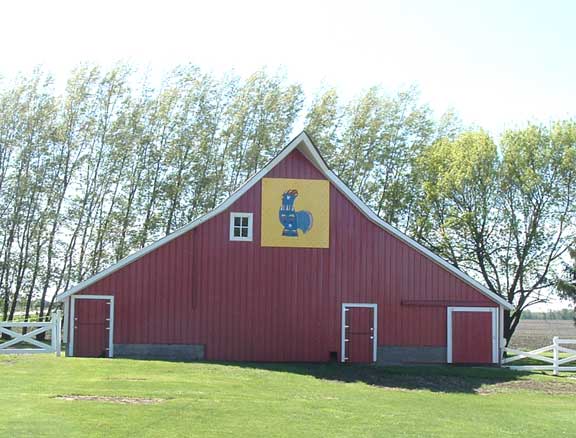
A new creature discovered at Swede Bend: the "Dala Rooster"
decorates the restored barn at Larsons B & B
Now to continue with the tour westward past Wayne and Carol Larsons' place, the "gateway to West Swede Bend". Local people frequently mention a place across the river called "Hardscrabble", but it does not appear on the maps. One old map shows a village platted on the west bank of the river, called Linnberg. When we asked about Linnberg, someone chimed in "that's Hardscrabble." Two mysteries solved. We received directions to the place, but since only one house reportedly survives there, did not venture to find it.
Picking up our tour guide, Dianne, we had a look at her albums of pictures of Dayton churches. Great! Then a trip around town to Emanuel Lutheran, her church. She had a picture including both old and new buildings side by side before the former was torn down. She also had a picture of something still new to us, a "young peoples' church" similar in concept to the one we saw in Marquette, KS, earlier. We are trying to figure out the logistics of these youth groups that had their own buildings. At Dayton, it was very much a miniature church.
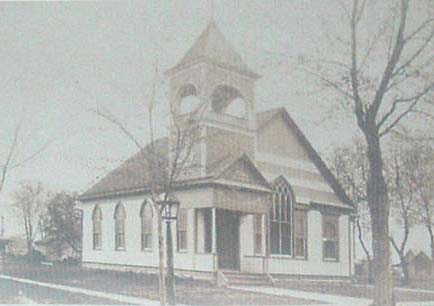

Eleanor spotted a "suspicious" building we titled "swedemaybe"
comparisons confirmed it was the old youth church, now a home
Just across the street from the Lutheran church (naturally) was the present day United Methodist church, which encorporated the earlier Swedish Methodist church whose building also is still standing. Remarkably, it is now occupied by the Missouri Synod Lutherans.
A block or two away was the site of the Mission church. The parsonage still remains, and Dianne remembers stopping to rest on the church steps on her way to school. Dayton is situated along a distinct valley and was once the meeting point for two railroads. O.M. Nelson has many details in his "Swedes of Iowa" which you may want to check, as is true for each of the places we will be describing. O.M. Nelson
On down the road we wanted to check the location of the Harcourt Covenant church which we intended to visit the next morning for their Sunday service. Faith Lutheran stands near the highway, an early building now part of Countryside Ministries cooperative. Just a few blocks south across the abandoned railway right of way stands the United Methodist (former Swedish) church, which was long ago acquired from the Evangelical church (we surmise, German Evangelical). And to the east a few blocks we found the Mission church looking very much like it did a century ago. So ended day one.



Reprise pictures of the Harcourt churches shown before
Lutheran, Methodist, Covenant; all of Swedish origin
The next morning dawned bright and clear once again, and we returned to Harcourt as planned, with only one stop to get a picture of the Swedish Methodist (now United, of course) church in Boxholm. As you see, it is another beautiful survivor. Also at Boxholm is Trinity Lutheran, the one that was moved in two pieces from Grant Center nearby. If you are wondering about the name, it came from a town in Sweden called...Boxholm. The land in the area is very level and corn was just emerging in visible rows. A farmer in Harcourt reported that 90% of his corn goes into ethanol.


Another reprise set, Boxholm Lutheran and Methodist
In the entryway to Harcourt Covenant church are the projected plans for a new church building. They have a prime 18 acre site secured, and our best wishes to them. We're glad, though, that we got to see the old church before it is gone. Rev. Laverne Sandstrom was pastor there for some time and has relatives still present. We remember him as interim in Wausa, at the time of my father's funeral. The chancel cross is dedicated to his memory. Also in the entryway is a display case showing another example of a silver communion chalis, and a very distinctive set of individual communion cups in wooden trays.
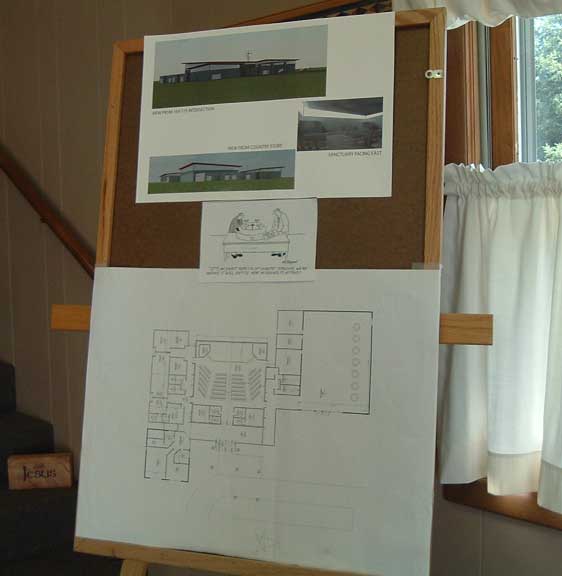

Future plans and past momentos. A picture of the earliest mission house peeks from behind
After goodbyes to pastors Craig and Kathy Vote, we headed south to Harcourt, where the congregation was just dispersing. Their church was described above; the place we found the Björk book. The line drawing of the old Chicago North Side Mission church found in their library was something of a revelation, it is just not commonly seen.
The impact of this image, and the difficulty we had in unearthing it, sets one to thinking. Ostensibly, historians have favored the earliest building...that's just the way historians are. But there may be something more. The picture in Björk's book reveals a church that was far more grand than we expected. Would it be unreasonable to speculate that there might have been some discomfort with it? Built at a time when the modest frame "mission house" was the norm across the Mission Friend communities, this must have stood out as a contrast. And no doubt the rank and file did not hesitate to make necessity a virtue in contrasting their modest mission houses to the ornate and expansive "worldly" churches around them (yes, even including Augustana Lutherans). But here we have a church that exceeded their own Chicago Lutheran neighbors in appearance and ornamentation. Was there some embarrassment in this? Just a thought.
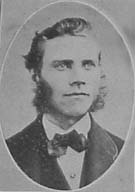
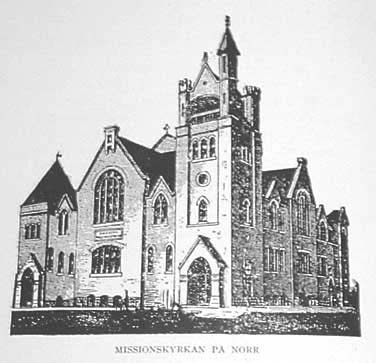
Lanyon discoveries of an 1870 Björk and his Chicago North Side church
To carry this one step further, it is not by chance that this picture emerged in the context of Björk's biography. No doubt it was sometimes casually refered to as "Björk's church," of that we may be sure. And since he was it's long-time pastor while also heading the Mission Synod it would have functioned as Synodic headquarters. Think of the 1885 formation of the Mission Covenant. The first meetings were held at the southside tabernacle. Then, after the decision was taken, the next meetings were in the northside church. Was this by design? The Ansgar and Independants would have been more comfortable in the "Skogsbergh" tabernacle, which was once itself independant. To begin the meetings on the north side would have suggested subjection to Björk and the Mission Synod. Would Princell even have shown up in Björk's church? Just another thought.


But the irony of finding our first look at the Chicago "mother church" in tiny Lanyon, Iowa, prompted another astonishment. Compare the overall impressions of the Lanyon church with the one in Chicago. Do you see similarities? The arrangement is remarkably similar, in mirror image. Was this by design? Lanyon has surely declined from its heyday, but leaves a peculiar impression of dignity and presence, befitting the role of being the only church in the town. But unlike its contemporary in Chicago Swedetown, it still exists in its original location. More on Lanyon
Then, straight back eastward to find Pilot Mound; what would it be like? At the previous day's meeting they told us there had been a Mission church there and that the building still stood. It is noted that the officers of the Swede Bend mission association and that of Pilot Mound were one and the same. With a name sounding like a remnant of the steamboat navigation days on the Des Moines River, Pilot Mound was home to a Mission Church surviving into rather recent times. The group was organized in 1868 by C.A. Björk and included the Burnquists among its 20 families. (A Burnquist was once governor of Minnesota) It was no doubt of the "mission society" style and one might speculate that more Dayton Lutheran members were involved. C.B. Johnson remembers that missionfriend Martin Sundin came to Pilot Mound from Chicago in the '60's. Sundin and Hans Blom had come from the Gävle Mission Society in Sweden. Schoolhouse quarters served the group until 1914, when a church was built. 45 members are listed in the 1930's time frame.

Pilot Mound church when new (permission applied for)
(looking south east)
Here there was something of a surprise. The prominent building has not only survived, but is a substantial looking brick structure, well-preserved as a private dwelling! What an irony that buildings survive when congregations do not.
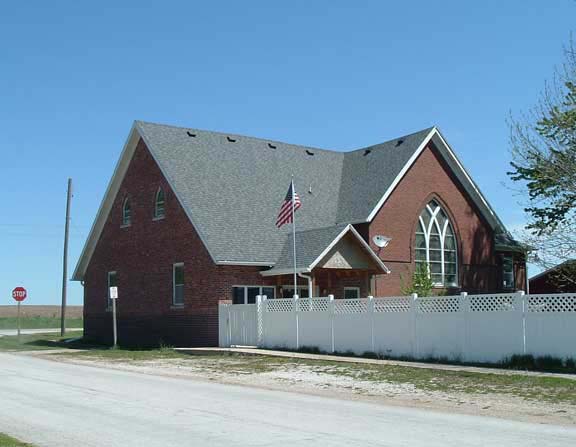
Pilot Mound as a private residence today (looking north east)
Here is a sampling of what O.M. Nelson has to say about Pilot Mound:
The name of Pilot Mound was first given to a mound of earth, used by the Indians as a lookout point, and at some time as a burial place, numerous human bones having been discovered there. Swedish settlers located in the vicinity in the sixties, coming mostly from Swede Bend (Stratford) in Hamilton county. One of the first ones was Gust Linn, who with his wife Catherine (Lundblad) emigrated from Sweden to United States in 1852, and came direct to Boone county. He was a carpenter and worked at his trade for some time. Later he purchased land in Pilot Mound township. During the Civil war he enlisted in Company D. Thirty-Second Iowa Volunteer Infantry, and remained with the command about two years. For 14 months he was held prisoner at Tyler, Texas. He died in 1897. His son W. Linn became postmaster at Pilot Mound. The Minneapolis & St. Louis railroad having been built through the settlement in 1880, the town of Pilot Mound was laid out Sept. 8, the following year. A postoffice by that name had existed there several years previously. The town is located about one-half mile northwest of the mound, for which it was named. Of a population numbering 274 only about a dozen families are of Swedish descent. Five of its business men are of Swedish birth. Most of them are sons of early Swedish pioneers. O. W. Tornell, who has conducted a hardware store in Pilot Mound since 1892, is a son of Olof Tornell, who was born in Hälsingland, Sweden, and emigrated to Swede Bend in 1865... A weekly paper, The Pilot Mound Monitor, was started in 1898 by August Samuelson who became its first editor and proprietor, but sold it soon afterwards to A. J. Wolf.
Though few Swedes live in the town of Pilot Mound, quite a number of Swedish farmers reside in the surrounding country, and compose most of the membership of the Swedish Mission Church, located in town. The congregation was organized in 1868 by the Reverend C. A. Björk from Swede Bend. Some 20 families, among them John Burnquist, composed the first membership. During the first year services were conducted in school houses, until a church was built. The present church was erected in 1914. The congregation now numbers about 45 members.
Continuing eastward across the scenic Des Moines River valley brought us to Ridgeport. It does not appear on some maps, but was the location in which Björk plied his trade as shoemaker during his earliest days in the Swede Bend region. It had been described as a vantage point providing a sweeping view of the valley, which indeed it was.

Viewing the Des Moines valley toward Swede Bend
Ridgeport is also known as Mineral Ridge
The tidy little community preserves a non-Swedish church, hilltop cemetery, and a butcher shop which appeared to be the only surviving commercial enterprise. The Björk shoe shop; long gone.
Following lunch back in Boone, it was westward ho!, to Ogden and the obscure colony of Moingona. The Winquists' guide was particularly helpful here, in listing the addresses of the Ogden Augustana and Mission churches. The Lutheran congregation continues in a stately old brick structure, but here again a very handsome brick Mission church has become the home of a private party. It would be so interesting to see how the interiors of Ogden and Pilot Mound have been adapted to family dwellings!
Due south of Ogden is the rural Swede Valley Lutheran church, founded in 1868, with its attendant churchyard cemetery.
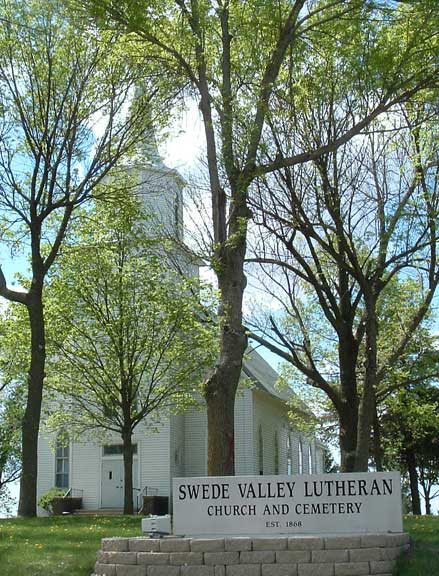

A few miles to the east, the road to Moingona descends into the river valley where large new homes are appearing in wooded estates, leaving no trace of coal mining days.
Moingona had been a mining town of several hundred people; that forgotten chapter of Iowa Swedish history in which immigrants took jobs at the coal mines then operating. The mental image of an old mining center is one of desolation and abandonment. It was a pleasant surprise to discover that this image was far from true. O.M. Nelson has given us a good picture of old Moingona:
Moingona was a product of the Chicago & Northwestern railroad and of the coal mines in its immediate vicinity. It was laid out July 6, 1866, For some years the town prospered, its population increased to over 1,000, mostly miners, and a city government was maintained. Between 1867 and 1872 quite a number of Swedish immigrants were attracted to Moingona. Most of them got work in the mines, others secured farms in the vicinity. Three Swedish churches were organized. The Swedish Lutheran Church branched out from the Swede Valley Church in the country near by. It was organized in 1873, a church building was erected the following year, and the membership increased to 100. During the greater part of its existence it was served by the same pastor as the Swede Valley Church. Another Swedish Church was organized in Moingona by the Mission Friends, who also built a church. A few Swedish Baptists, who had located in Moingona, organized a Baptist Church June 24, 1885. It was served by Rev. C. W. Broms for a while, but did not continue its activity very long. Among the organizers were C. M. Nelson, L. J. Ahlstrom and Paul Johnson.

A preserved structure in Moingona suggestive of immigrant days
The straightening of the Northwestern railroad, removing the main line from Moingona, and leaving that town on a branch line of secondary importance, together with the giving out of the coal mines in the neighborhood, deprived the inhabitants of Moingona of their means of livelihood, and caused many of them to remove to other places. The shrinking of the population reacted on the business of the town, and year by year Moingona was reduced until only fragments now remain of a once thriving community. Both the Swedish congregations have ceased their activities, but until recently one of their churches was accessible for visiting ministers happening to come that way. Of the business houses only one store and a blacksmith shop (both operated by Swedes) remain. About a half dozen Swedish families still reside in the almost deserted village. The automobiles and the trucks taking what little traffic was left, the railroad has now discontinued all service over the road, and is ready to tear up the rails. Even the postoffice has been discontinued, the community now being served by rural route.
Swedeburg Nebraska pastor Andrew Hallner tells of receiving the urgent telegram from Björk: "take the train to Moingona", where at the meeting of the Mission Synod board he would receive the call to become its secretary and editor. Just where this meeting was held remains a mystery, but this schoolhouse preserved in Moingona surely suggests an image of what it must have looked like.
To the west of Moingona many Swedes settled as farmers in the level Iowa plains. The community called Swede Valley and Ogden on the railroad line is described by O.M. Nelson:
The town of Ogden owes its existence to the Chicago & Northwestern railroad, and was laid out by John I. Blair in 1866. It is situated on the main line of that road, 11 miles west of Boone. The Minneapolis & St. Louis railroad also passes through the town from north to south. The first residents of Ogden were William Patterson, John Regan and George Stanley, all railroad laborers. A. W. Blumberg was among the first merchants of Ogden. The town was incorporated in 1878. At that time Ogden had several Swedish families among its inhabitants. The settlement was originally named Swede Valley, and comprised a considerable number of Swedish miners and farmers, living in and around Moingona and Ogden.

The Ogden Lutheran church near downtown
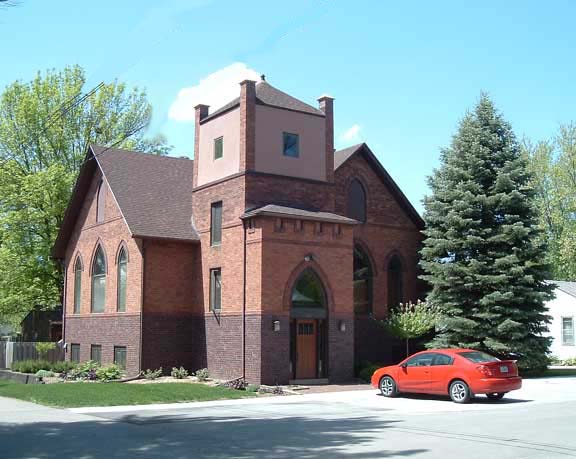
Another example of residential preservation of a beautiful old church, the Mission Covenant
The only regrets one might have in finding these sunny sites of yore is that there was not time to sit down with local residents and hear their stories. Hopefully, this internet medium of sharing and remembering might open some doors for just that kind of thing. But then, Swede Bend country is only a few hours away...